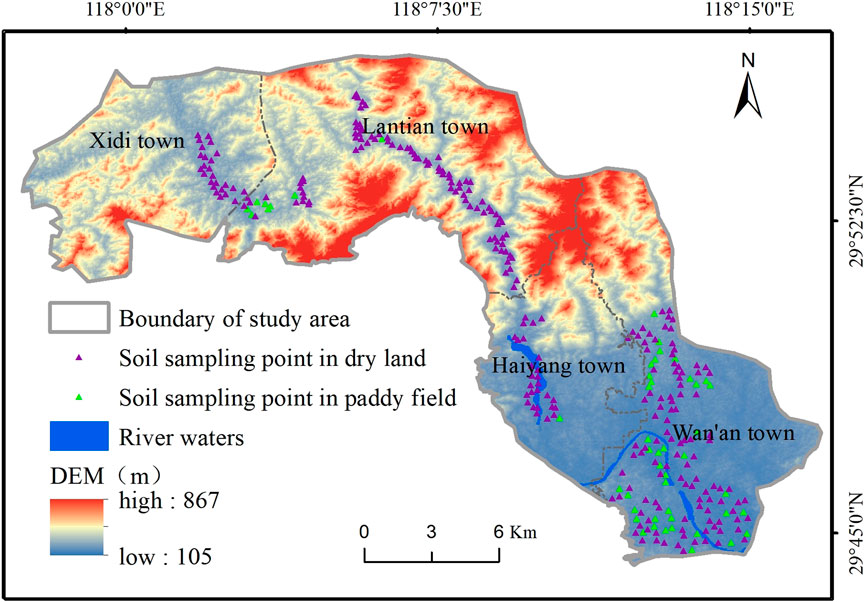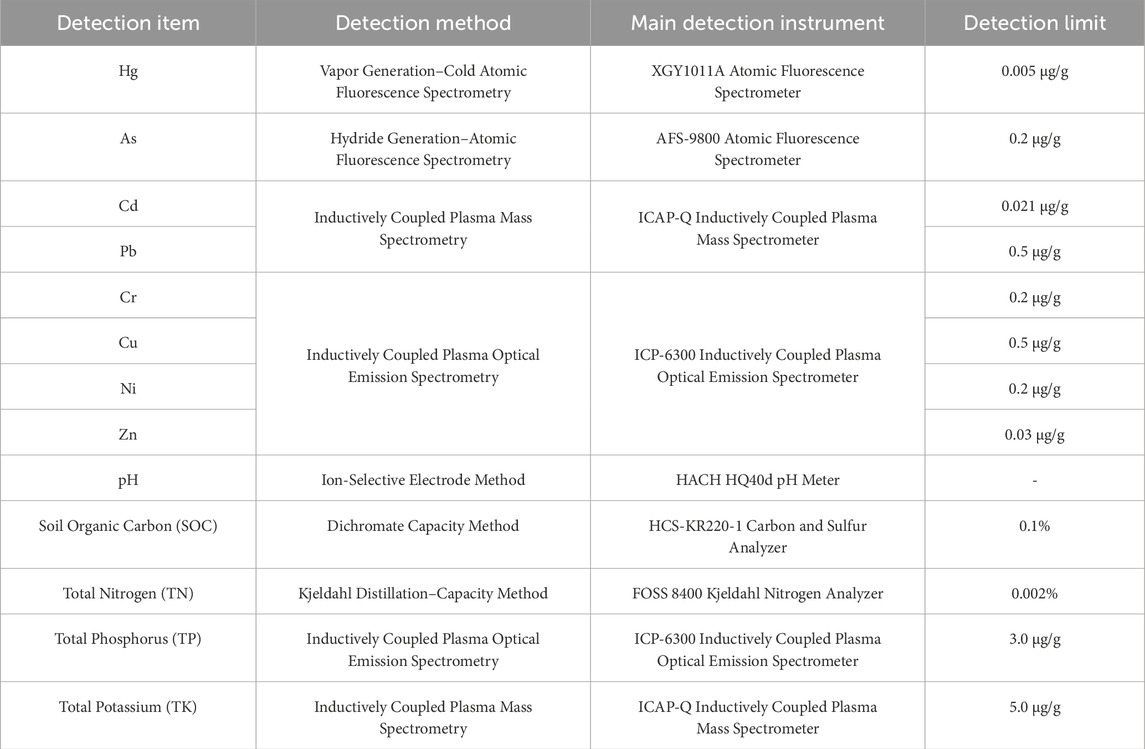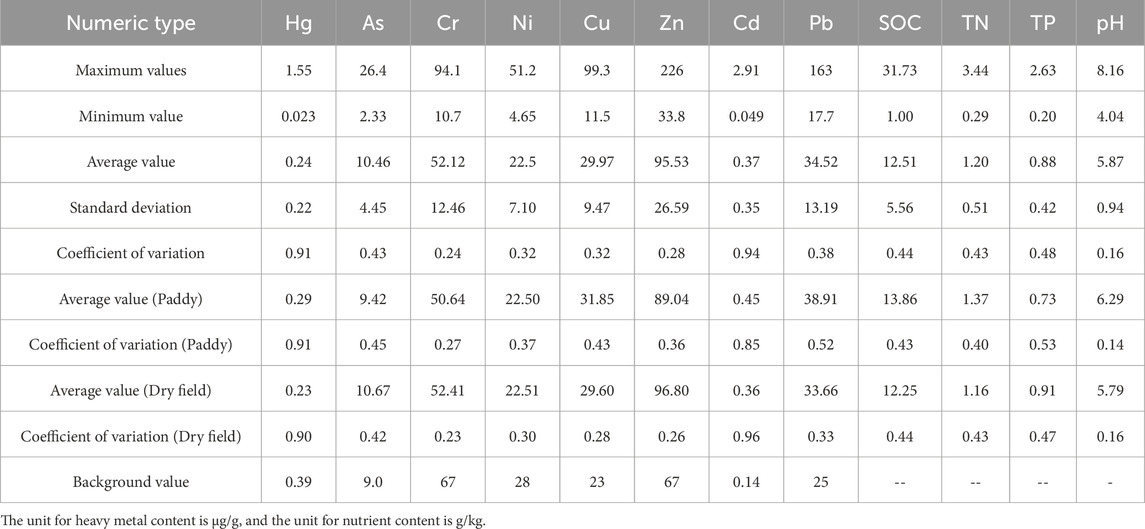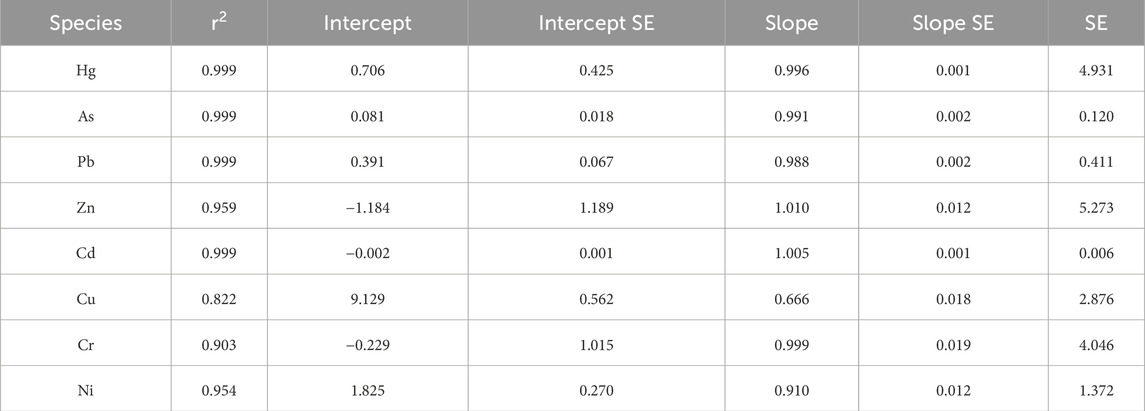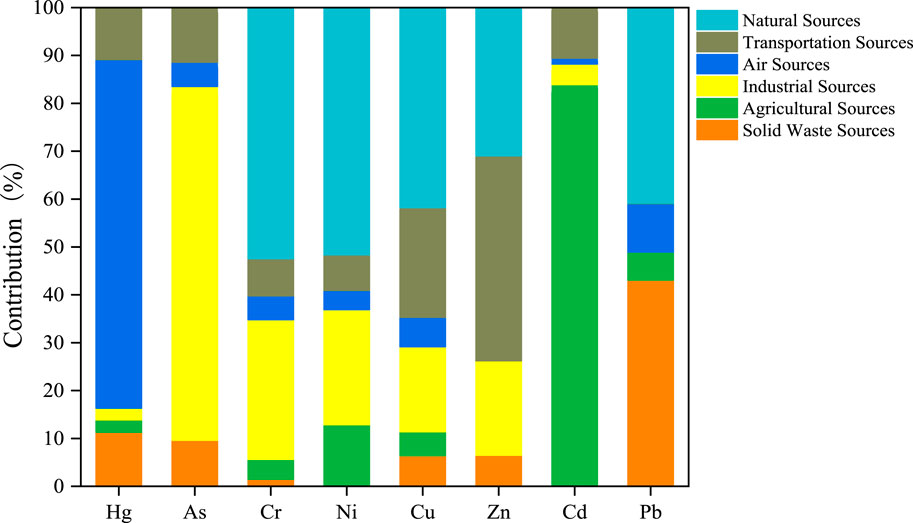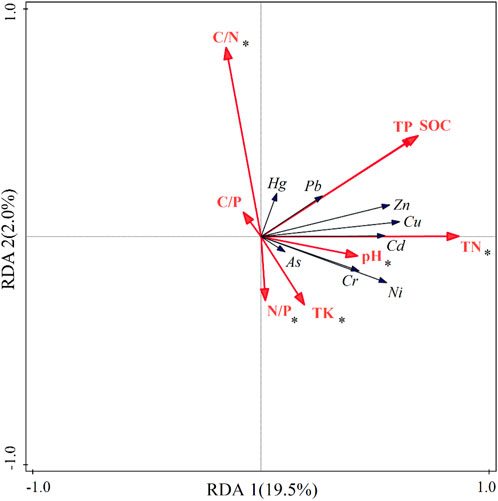- 1Huangshan Observation and Research Station for Land-water Resources, Huangshan, China
- 2Changsha General Survey of Natural Resources Center, China Geological Survey, Changsha, China
- 3Yantai Center of Coastal Zone Geological Survey, China Geological Survey, Yantai, China
- 4Ministry of Natural Resources Observation and Research Station of Land-Sea Interaction Field in the Yellow River Estuary, Yantai, China
- 5Key Laboratory of Natural Resource Coupling Process and Effects, Beijing, China
To clarify the characteristics of heavy metal (Hg, As, Cd, Cu, Zn, Pb, Ni, Cr) contamination in farmland within mountainous basin areas and investigate the influence mechanisms of soil nutrient factors (organic carbon SOC, pH, total nitrogen TN, total phosphorus TP, total potassium TK) and the C:N:P ratio on heavy metal pollution, This study selected a typical mountainous valley area within the Huangshan section of the Xin’anjiang River basin. A total of 300 soil samples were collected. Kriging interpolation was employed to assess the spatial distribution of heavy metal contamination. A positive definite factor matrix model was used for source analysis of soil heavy metals. Combined with redundancy analysis, correlation analysis, and structural equation modeling, the study investigated the influence mechanisms and distribution drivers of soil factors on soil heavy metal contamination. Results indicate: (1) Overall, heavy metal contamination in farmland across the study area was predominantly mild or below (>75%). Contamination was concentrated in the lower-elevation areas east of Xidi Town and west of Lantian Town, with notably elevated Cr, Cu, Zn, and Cd concentrations in these zones; (2) Atmospheric sources contributed most to Hg (72.8%); As was primarily influenced by industrial sources (73.9%); natural sources were the main contributors for Cr, Ni, and Cu, accounting for 52.5%, 51.7%, and 41.8%, respectively; soil Zn primarily originated from natural and transportation sources (31.0% and 42.8%); Agricultural sources dominate Cd contributions (83.9%); Pb is primarily influenced by natural sources and solid waste sources (40.9% and 43.1%, respectively); (3) Redundancy analysis indicates soil nutrient factors explain 21.5% of heavy metal pollution, with TN contributing the most at 63.4%; Both linear regression and structural equation modeling results indicate a significant negative correlation (p < 0.05) between the C:P ratio and the comprehensive soil heavy metal pollution index. This may be due to the fact that farmland in mountainous basin areas has a higher proportion of P compared to the average C:N:P ratio of subtropical farmland, and P can effectively bind with heavy metals (Cu, Cd, Pb, Ni, Zn) to form a stable state. This study systematically evaluates the heavy metal pollution in the Huangshan section of the Xin’an River from contamination assessment, source analysis, and impact mechanisms, offering a theoretical basis for preventing and controlling heavy metal pollution and ensuring land safety in similar regions.
1 Introduction
The Xin’an River is located in a key grain-growing area of the middle and lower Yangtze River. With local agriculture, mining, transport, tourism, and industry booming, the soil has become heavily polluted with heavy metals like Hg, As, Cd, Cu, Zn, Pb, Ni, and Cr. Studies show that these metals originating from human production activities enter farmland and water via atmospheric deposition, phosphate fertilizers, animal manure, and soil runoff, harming crop yield and quality. They can also move up the food chain to humans, endangering health and complicating China’s agricultural and food safety (Hu et al., 2016; Lu, 2016; Meers et al., 2010; Yang et al., 2016). In mountain basins, the terrain may cause heavy metals to accumulate via water flow, mud and stone transport, and natural deposition, rendering these areas prone to heavy metal pollution (Chen et al., 2025). Research has demonstrated that human activities related to mining can contribute to elevated levels of heavy metals in low-lying foothill areas and river irrigation regions, often exceeding those observed in surrounding high-altitude areas (Pan et al., 2022). Therefore, identifying the characteristics of heavy metal pollution in mountainous basins is crucial in order to prevent and control pollution in the region.
Relevant studies have shown that farmland soils in the middle and lower reaches of the Yangtze River in various provinces have different degrees of excess Cd, Cu and Zn content at different scales (Xu et al., 2018). In farmland ecosystems, the levels of CNP nutrients and their stoichiometric ratios are key indicators of soil fertility and health (Wang et al., 2018). Many studies have traced soil heavy metal pollution sources and assessed its ecological impacts (Li S. L. et al., 2024; Li W. B. et al., 2023). While other studies have focused on heavy metal speciation and leaching toxicity in surface soil (Liu et al., 2023). However, few studies have explored how soil nutrient factors affect heavy metals in farmland (He et al., 2023; Xiao et al., 2024). CNP nutrients share sources with heavy metals. For example, applying animal manure adds nutrients but also heavy metals (Huang et al., 2018). Moreover, CNP nutrients can bind with heavy metals to form complexes, altering their soil chemistry and transport. Organic carbon in soil can form stable complexes with heavy metals like Cr, As, Cu, Cd, Pb, Zn, and Fe, reducing their solubility and bioavailability (Qin Q. Q. et al., 2023). Nitrogen forms (ammonium and nitrate) differently affect heavy metal adsorption. Ammonium may compete with Cd and Pb cations for adsorption (Zhou et al., 2025), while nitrate can promote Cu and Zn redox reactions (Xu et al., 2022). Phosphorus can form insoluble phosphate precipitates with As and Pb, lowering their soil solution concentrations and reducing their toxicity and mobility (Liang et al., 2024). In addition, CNP nutrient content and proportions may significantly affect plant growth and microbial activity, which plays an important role in the absorption, accumulation, and tolerance of heavy metals (such as Zn, Cu, and Cd) (Chen et al., 2023; Dovletyarova et al., 2023; Wang et al., 2022). These studies show a complex link between soil CNP nutrients and heavy metal pollution, but most are small - scale or reviews. Few studies have examined this relationship at the regional level (Dovletyarova et al., 2023; Zhou et al., 2025).
Overall, studying regional farmland soil heavy metal pollution and CNP nutrient - driven mechanisms can help reduce pollution risks, limit heavy metal accumulation in crops, and ensure food safety and human health. This study focuses on the Xin’an River’s Huangshan section. It assesses heavy metal pollution and, from a soil nutrient perspective, uses Pearson correlation and redundancy analyses for pollution classification and structural equation modeling for mechanism exploration. The goal is to clarify typical small - basin farmland pollution in the middle and lower Yangtze River region and explore how soil nutrients and stoichiometric ratios affect heavy metal levels. This can aid similar regions in preventing and controlling farmland soil heavy metal pollution and ensuring land safety.
2 Materials and methods
2.1 Study area overview
This study selected the Xin’anjiang River Basin section in Huangshan City, Anhui Province, China (118°0′0″E–118°15′0″E, 29°45′0″N–29°52′30″N) as the study area. The region has a subtropical monsoon climate with abundant rainfall and concurrent heat and rain. The annual average rainfall is 1,395–1,702 mm, and the annual average temperature is 15.50 °C–16.40 °C. The terrain is predominantly hilly with an elevation of 105–867 m. The main soil types are yellow soil, mountain yellow-brown soil, and red soil.
The Xin’anjiang River originates in Huangshan City, Anhui Province, with a main stream length of 242 km and a watershed area of 5,856 km2 within Huangshan City. The average outflow water volume accounts for more than 68% of the inflow water volume of Qiandao Lake in Zhejiang Province. The Xin’anjiang River is an important water source for the production and living needs of Huangshan City, Anhui Province, and Hangzhou City, Zhejiang Province, and is also a critical ecological barrier and strategic water source for the downstream regions of the Yangtze River Delta. Therefore, this study selected the Huangshan City section of the Xin’anjiang River Basin as the research area.
2.2 Sample collection and processing
2.2.1 Sample collection
Soil samples were collected in farmland in Xidi Town, Lantian Town, Haiyang Town, and Wan’an Town in accordance with the “Land Quality Geochemical Evaluation Specification” (GB/T 0295–2016). The sampling depth was 0–20 cm, with a sampling density of 5 points/km2. Sampling points were appropriately densified in valley areas. During sampling, areas with recent human pollution or recent land accumulation were avoided. Using the “plum blossom sampling method,” multiple points were sampled, and plant roots and other debris were removed. Finally, the samples were mixed into one sample, with each sample weighing no less than 1,000 g. A combination of grid-based and random sampling methods was used, with a total of 300 sampling points, including 49 paddy field points and 251 dryland points (Figure 1 for specific sampling point distribution).
2.2.2 Sample analysis
After natural air-drying, the soil samples were preliminarily processed, crushed manually with a wooden hammer, and passed through 100-mesh and 200-mesh sieves. The samples were then divided using the quartering method and transported to the laboratory. The soil samples were analyzed by the Yantai Coastal Zone Geological Survey Center of the China Geological Survey, following the standards of the “Regional Geochemical Sample Analysis Method” (DZ/T 0279.27–2016) and the “Determination of Sulfur Content in Gold Ores by High-Frequency Combustion Infrared Absorption Method” (SN/T 4366–2015). The detection parameters included As, Cd, Cr, Cu, Pb, Hg, Ni, Zn, pH, total nitrogen, total phosphorus, total potassium, and soil organic carbon. Specific detection methods are shown in Table 1.
2.3 Research methods and data processing
2.3.1 Single factor pollution index method
The single factor pollution index method determines the degree of pollution by comparing the measured value with the corresponding standard or background value (Yang P. Z. et al., 2024). The calculation formula is shown in Equation 1.
where Pi is the single factor pollution index of the i-th heavy metal in the soil, Ci is the measured concentration of the i-th heavy metal in the soil, and Si is the evaluation standard value of the i-th heavy metal. This study used the geochemical background values of Anhui Province’s soil as the evaluation benchmark (Yang Z. et al., 2024). The classification of the single factor pollution index is shown in Table 2.
2.3.2 Nemero pollution index method
The Nemero pollution index method evaluates soil pollution by calculating the arithmetic mean and maximum value of multiple pollutant single factor pollution indices, providing a more comprehensive pollution assessment (Zhang et al., 2024). The calculation formula is shown in Equation 2.
where PN is the Nemero pollution index, (Ci/Si)max is the maximum value of the heavy metal pollution index, and (Ci/Si)ave is the average value of the heavy metal pollution index. The classification of the Nemero pollution index is shown in Table 3.
2.3.3 Positive matrix factorization (PMF)
Positive Matrix Factorization (PMF) is a multivariate factor analysis model that decomposes sample data matrices into factor contribution matrices and factor spectrum matrices to identify pollution sources and quantitatively calculate their contributions (Ma et al., 2023). The calculation process is shown in Equations 3–6:
where Xij is the concentration of the j-th element in the i-th sample of the observation data matrix X, Gik is the contribution of the k-th source to the i-th sample in the source contribution matrix G, Fkj is the influence of the k-th source on the j-th element in the factor load matrix F, Eij is the residual of the j-th element in the i-th sample of the residual matrix E, Q is the objective function defined by the PMF model, Uij is the uncertainty of the j-th element in the i-th sample, RSD is the relative standard deviation, and MDL is the detection limit. When the measured value of the heavy metal is greater than the MDL, Equation 5 is used; when the measured value is less than the MDL, Equation 6 is used.
2.3.4 Data processing
The content and coefficient of variation of heavy metal elements were calculated using Excel 2019. Pearson correlation analysis was performed using OriginPro 2021 software for calculation and plotting. The spatial distribution map of heavy metals was drawn using ArcGIS 10.7 software through Kriging interpolation spatial analysis. The Fisher test-based structural equation model was constructed using R 4.4.1, redundancy analysis was performed using Canoco 5 software, and positive matrix factorization was calculated using EPA PMF5.0 software.
3 Results
3.1 Characteristics of heavy metal content in farmland soils of the Xin’anjiang River Basin
The soil pH values in the Xin’anjiang River Basin ranged from 4.04 to 8.16, with an average value of 5.87, indicating overall acidic soil. Overall, the average content of Hg, Cr, and Ni in the soil of the Xin’anjiang River Basin was lower than the background values, while the average content of As, Cu, Zn, Cd, and Pb was 1.16, 1.30, 1.43, 2.66, and 1.38 times the background values, respectively. Comparing the variation extent of soil heavy metal content, Cr and Zn showed slight variation, As, Ni, Cu, and Pb showed moderate variation, and Hg and Cd showed high variation. Different farming environments can lead to significant differences in soil environments. Therefore, farmland was divided into paddy and dryland types for comparison (Table 4). The soils in both paddy and dryland areas of the Xin’anjiang River Basin were acidic, but the pH value of paddy soils was higher than that of dryland soils, overall weakly acidic. The average content of Hg, Cd, and Pb in paddy soils was 1.24, 1.24, and 1.16 times that of dryland soils, respectively. As and Zn in paddy soils reached 88.30% and 91.98% of those in dryland soils, respectively. The content of Cr and Ni in the two types of farmland areas showed little difference. By comparing the variation extent of soil heavy metal content in different farmland types, it was found that, except for Zn in paddy fields reaching moderate variation and Pb reaching high variation, the variation extent of soil heavy metal content in the two types of farmland was consistent with the characteristics of the overall situation. The C:N:P ratio of farmland soil in the study area was 14.3:1.4:1, and it was subject to a certain degree of human interference. The coefficient of variation for organic carbon, total nitrogen, and total phosphorus content in the soil reached moderate levels in both paddy fields and dry fields. There were no significant differences in the content of organic carbon, total nitrogen, and total phosphorus between the two types of cropland soils. However, on average, the TP content in upland fields was 1.25 times that of paddy fields, while SOC and TN were 88.42% and 84.80% of those in paddy fields, respectively.
3.2 Evaluation of heavy metal pollution in farmland soils of the Xin’anjiang River Basin
The single factor pollution index can quickly identify the pollution level of various heavy metals in the soil and warn of potential heavy metal pollution risks (Figure 2). Overall, except for the difference in Cd pollution levels between paddy (heavy) and dryland (moderate), the pollution levels of other heavy metals were the same in both types of farmland: As, Cu, Zn, and Pb were mildly polluted, while Hg, Cr, and Ni did not reach pollution levels. Overall, the heavy metal pollution levels in paddy soils were Cd > Cu > Zn > Pb > As > Ni > Cr > Hg, and in dryland soils, they were Cd > Zn > Cu > Pb > As > Ni > Cr > Hg.
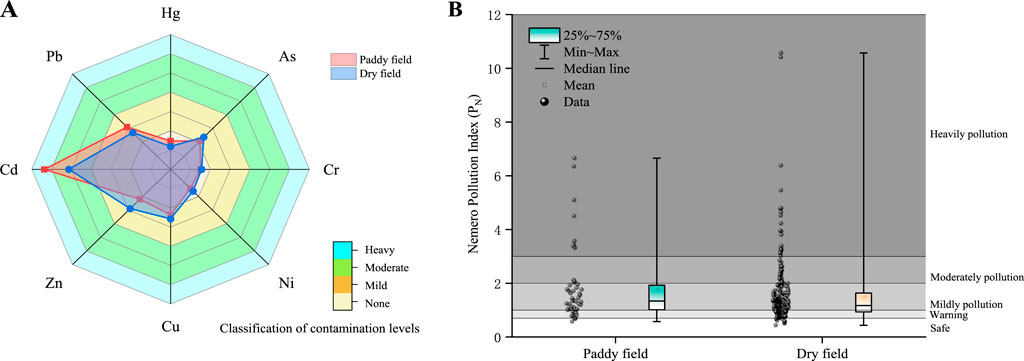
Figure 2. Single factor pollution index (A) and nemero pollution index (B) under different farmland types.
The Nemero composite pollution index can comprehensively evaluate the pollution status of various heavy metals, providing a more overall judgment of soil heavy metal pollution based on the weights of different heavy metals (Figure 2). The heavy metal pollution levels in paddy and dryland soils in the Xin’anjiang River Basin were mostly at the warning and mild pollution levels. The Nemero composite pollution index of heavy metals in paddy soils ranged from 0.57 to 6.65, with a median and mean of 1.34 and 1.78, respectively. The Nemero composite pollution index of heavy metals in dryland soils ranged from 0.43 to 10.57, with a median and mean of 1.17 and 1.54, respectively.
Based on Kriging interpolation, the spatial distribution of heavy metals and nutrient factors in the study area was evaluated (Figure 3). Hg is primarily concentrated in the foothills of the western part of Lantian Town, as well as in the basin areas of the southern parts of Haiyang Town and Wanan Town. As is distributed relatively uniformly in the eastern part of Xidi Town, as well as in Lantian Town, Haiyang Town, and Wanan Town. Cr is primarily concentrated in the eastern part of Xidi Town and the western part of Lantian Town, with limited distribution in other areas. Ni is distributed relatively uniformly throughout the study area. Cu is primarily concentrated in the mountainous valleys at the junction of the eastern part of Xidi Town and the western part of Lantian Town, similar to Zn and Cd, which are also concentrated in these areas. Pb is primarily distributed in the western part of Lantian Town and the southern basin areas of Haiyang Town and Wanan Town. Soil organic carbon in the study area is primarily distributed in the mountainous valleys at the western boundary between Lantian Town and Xidi Town, as well as in the northern foothill regions of Wanan Town. Soil total nitrogen concentrations are higher in the mountainous valleys at the western boundary between Lantian Town and Xidi Town. Regions with higher soil total phosphorus concentrations are primarily the foothill areas west of Lantian Town and the basin regions east of Wanan Town. The spatial distribution of the Nemero index showed that heavy metal composite pollution was more severe in the eastern part of Xidi Town and the western part of Lantian Town, while pollution levels were lower in other areas.
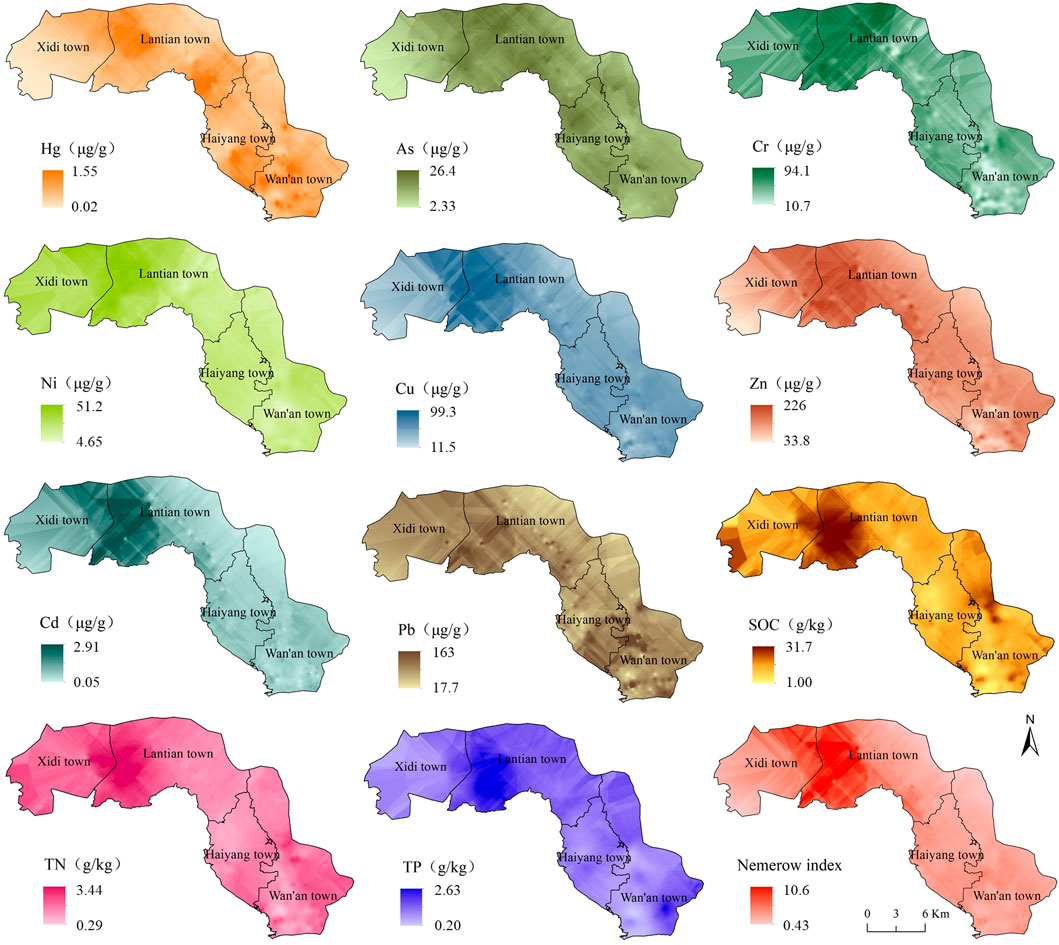
Figure 3. Spatial distribution of heavy metal content, nutrient content, and Nemero index in the study area under Kriging interpolation.
This study performed PMF source apportionment of the eight heavy metals in the soil. The model parameters showed that when the number of sources was set to 6, the correlation coefficient r2 of the heavy metals, except for Cu (0.822), was above 0.9, indicating good model performance (Table 5). The results of the PMF source apportionment (Figure 4) showed that soil heavy metal pollution was mainly influenced by traffic sources, natural sources, atmospheric sources, industrial sources, agricultural sources, and solid waste sources. Atmospheric sources contributed the most to Hg, accounting for 72.8% of the total contribution. As was mainly influenced by industrial sources, with a contribution rate of 73.9%. Natural sources were the main contributors to Cr, Ni, and Cu, accounting for 52.5%, 51.7%, and 41.8%, respectively. Zn was mainly derived from natural and traffic sources, accounting for 31.0% and 42.8%, respectively. Cd was primarily affected by agricultural activities, with agricultural sources contributing 83.9%. Pb was mainly influenced by natural and solid waste sources, accounting for 40.9% and 43.1%, respectively.
3.3 Correlation analysis of heavy metal content in farmland soils and soil factors
Soil C, N, and P content and their stoichiometric ratios are core indicators for assessing soil function, health, and nutrient cycling efficiency. In this study, the soil C, N, and P characteristics (Figures 5, 6) showed no significant differences in nutrient profiles between dryland and paddy soils. Overall, soil N and P levels showed little variation, with their primary ranges (25th–75th percentiles) being 0.85–1.41 g/kg and 0.58–1.06 g/kg, respectively. In contrast, soil C content displayed a clear gradient, ranging mainly from 8.80 to 15.20 g/kg. The soil nutrient stoichiometric ratios were primarily characterized by a C:P gradient (10.66–19.64), while C:N and N:P ratios were more narrowly distributed.
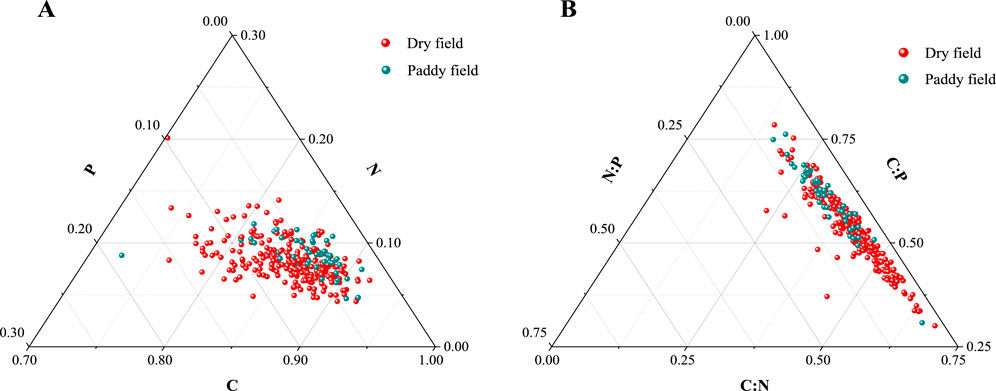
Figure 5. Ternary plot of C:N:P (A) and its stoichiometric ratio (B) at the study sample site, On the coordinate axis, C, N, and P represent organic carbon, total nitrogen, and total phosphorus, respectively.
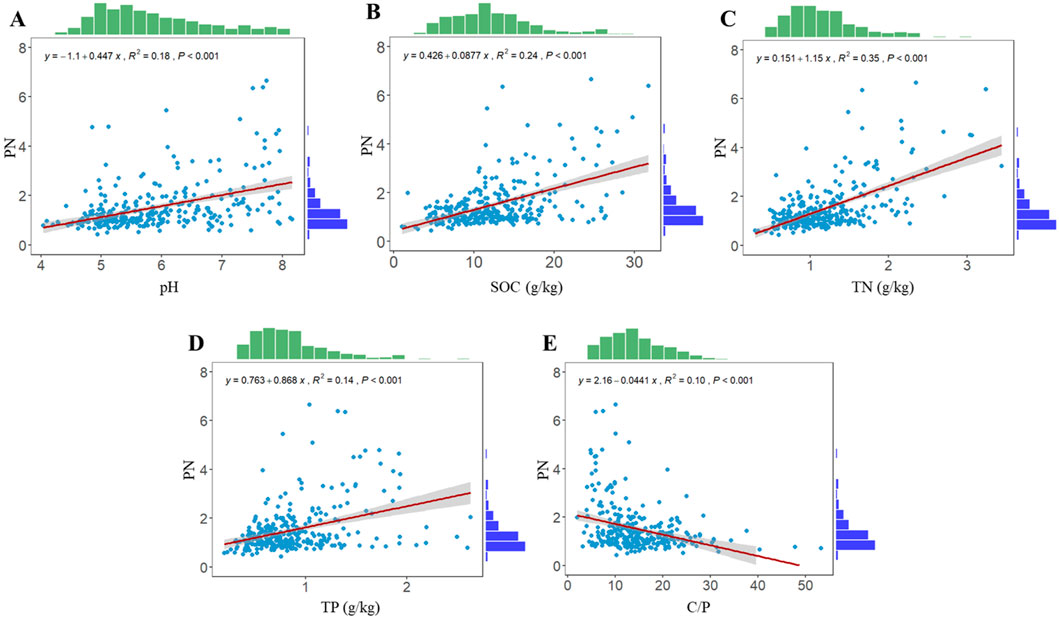
Figure 6. Linear relationship between Nemero index and soil factors (A-E) represent the linear regression relationships between soil pH, SOC, TN, TP, and C:P ratio with comprehensive heavy metal contamination levels in soil.
A linear regression model (Figure 6) linking the heavy metal composite pollution index to soil factors helps clarify the relationship between soil nutrients and heavy metal pollution. In this study, the PN index showed significant positive correlations with soil pH, SOC, TN, and TP, and a significant negative correlation with C:P (p < 0.001).
The correlation between heavy metal content and important soil factors in the farmland soils of the Xin’anjiang River Basin is shown in the Figure 7. As, Cr, Ni, Cu, Zn and Cd showed significant correlations with each other (p < 0.05). In the correlation analysis of heavy metals in soil, Pb showed no significant correlation with Cr but exhibited significant positive correlations with other heavy metals. Hg only had significant negative correlations with Cr and Ni in soil and significant positive correlations with Cu and Pb (p < 0.05). Regarding the correlation between soil nutrient factors and heavy metals, soil SOC, TN, and TP showed significant positive correlations with heavy metals except for Hg and As (p < 0.05). From a stoichiometric perspective, only C:N showed significant negative correlations with Cr and Ni, while C:P and N:P showed significant negative correlations with As (p < 0.05).
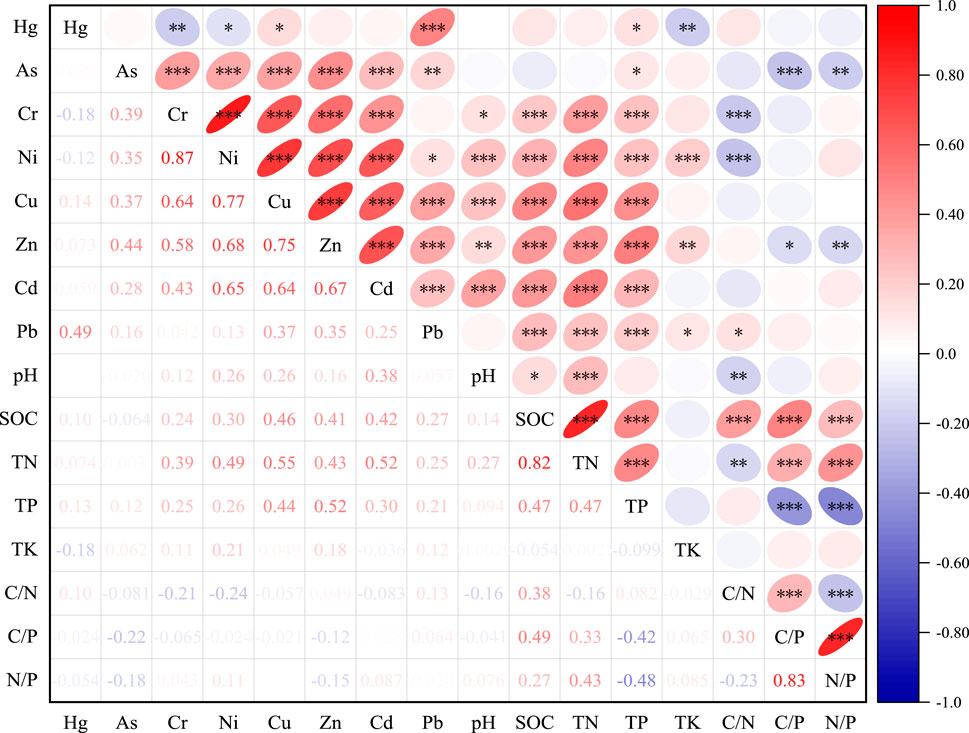
Figure 7. Correlation of soil heavy metal elements and soil factors in Xin’anjiang River Basin, *p < 0.05, **p < 0.01, ***p < 0.001.
As shown in Figure 8 redundancy analysis can clarify the overall explanatory ability of soil factors on heavy metals. In this study, TN, N:P, TK, C:N and pH contributed 61.4%, 15.7%, 8.3%, 6.2%, and 4.0% of the variation in soil heavy metal content, respectively (p < 0.05). After dimensionality reduction, the comprehensive explanatory degree of soil factors reached 21.54%. The heavy metals in the soil are mainly distributed across two quadrants. Based on their projection distance and direction relative to the interpretive axes and environmental factors, they can be preliminarily divided into five groups:Hg lies close to the second interpretive axis; in the first quadrant, Pb has a positive correlation with TP and SOC, Zn, Cu, and Cd are close to the first interpretive axis; Cr and Ni are in the fourth quadrant, influenced by the first axis of interpretation and pH; As has a small interpretive degree.
By constructing a structural equation model between soil factors and different heavy metals (Figure 9), the potential relationships between soil factors and heavy metals can be identified, and the influence coefficients of each factor on soil heavy metals can be clarified. The soil Cu content was significantly directly linked to pH, TN, and C:P, with path coefficients of 0.10, 0.64, and −0.28, respectively. C:P was significantly influenced by pH, SOC, and TP, with path coefficients of −0.10, 0.90, and −0.84, respectively (p < 0.05). Cd had a similar model to Cu, with influence coefficients of 0.23, 0.56, and −0.28 for pH, TN, and C:P, respectively. Pb was directly affected by SOC and TK (path coefficients of 0.54 and 0.13, respectively, p < 0.05) and driven by C:P, C:N, and N:P (path coefficients of −0.74, 0.27, and 0.62, respectively, p < 0.05). TN directly affected Ni content (path coefficient of 0.66) and indirectly suppressed it via N:P (path coefficient of −0.22). Zn content was directly influenced by TN, TP, and TK (path coefficients of 0.20, 0.45, and 0.22, respectively) and had no significant direct path relationship with C:N:P. The structural equation model of soil nutrient factors with the PN index, similar to Cu and Cd, was directly path - affected by pH, TN, and C:P (0.20, −0.41, and 0.52, respectively).
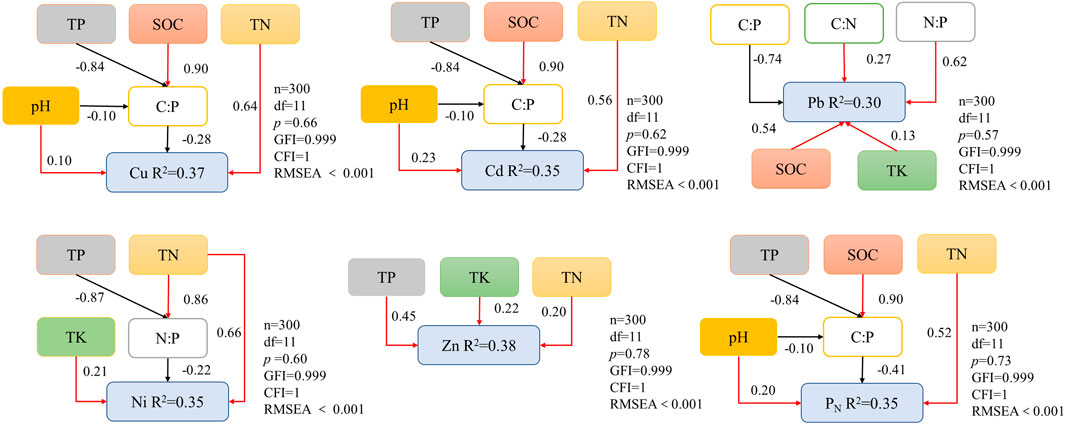
Figure 9. Structural equation modeling between soil factors and different heavy metals, Numbers in the figure represent standardized path coefficients; solid lines indicate p < 0.05, dashed lines indicate otherwise; red lines indicate positive correlations, black lines indicate negative correlations.
4 Discussion
4.1 Characteristics of heavy metal pollution and source apportionment
The results of the single-factor pollution index and Nemero pollution index in this study (Figures 2, 3) indicate that Cd is the primary heavy metal contaminant in the farmland soils of the study area, with generally low levels of heavy metal composite pollution. Only a small portion (<25%) of the region experiences moderate to severe contamination. The spatial distribution patterns (Figure 3) show that different heavy metals have distinct spatial distribution characteristics, yet they also exhibit similar distribution patterns. This is because soil heavy metal pollution levels are influenced by multiple sources, leading to regional variations (Yuan et al., 2021). Positive matrix factorization (PMF) analysis for the eight heavy metals in this study (Figure 4) shows that Hg is predominantly sourced from atmospheric origins, aligning with previous studies (Hu et al., 2018). As is often present as a by-product or raw material in chemical industry processes, such as mining and manufacturing of glass and paints (Ma et al., 2019), matching the industrial structure of the study area. Cr and Ni, with similar configurations, are widely present in soil formation processes and parent materials due to natural sources (Yi et al., 2024). This is consistent with the low coefficient of variation and uniform distribution observed in this study, and the significant positive correlation between Cr and Ni (Table 4; Figures 3-7). Cu and Zn also exhibit significant positive correlations and similar source contributions (Figures 3-7), likely due to inputs from vehicle tire wear, galvanized component corrosion, and automobile exhaust emissions, making traffic sources a significant contributor to Cu and Zn contamination (Fan et al., 2022). Previous studies have shown that the application of chemical fertilizers and pesticides leads to Cd accumulation in agricultural soils (Du et al., 2025), and the addition of straw and organic fertilizers, while enhancing soil nutrients, also increases the risk of heavy metal pollution (Li J. Q. et al., 2024). This is consistent with the significant positive correlations observed in this study between Cd and TN, TP, TK, and SOC (p < 0.05) (Figure 7). Regarding Pb source identification, leaching from solid waste is likely the main source. Previous studies have indicated that urban construction materials, municipal solid waste, and waste electrical and electronic products are important sources of soil Pb (Miao et al., 2022; Yeganeh et al., 2025).
Compared to the mean C:N:P ratio of 38:3.2:1 in subtropical farmland soils (Song et al., 2020), the study area exhibits higher P content and lower SOC content (C:N:P = 14.3:1.4:1). This may be related to the study area’s location in an intermontane basin (Figure 1). Phosphorus, cycling predominantly as a sedimentary cycle, is primarily present in rocks and minerals as phosphate. The relatively enclosed topography of the intermontane basin favors soil accumulation, and phosphorus in the soil undergoes redistribution through processes such as leaching and precipitation. Some areas may experience phosphorus enrichment due to precipitation effects (Li J. S. et al., 2023).
4.2 Coupling relationship between heavy metal pollution and soil factors
The coordination and driving relationship between soil nutrient factors and heavy metal content: On the one hand, heavy metal emission sources can contribute compounds containing C, N, and P to the soil. On the other hand, heavy metals in the soil are influenced by nutrient factors, altering their speciation and mobility (Tian et al., 2025). In this study, soil SOC, TN, and TP showed significant positive correlations with Ni, Cu, Zn, Cd, and Pb (p < 0.05) (Figure 7), and similar results were indicated by the structural equation model. The reasons may be as follows: from the perspective of pollution sources, traffic activities (such as automobile exhaust emissions and tire wear) release nitrogen oxides into the soil, increasing the nitrogen content contributed by traffic sources (Li Y. R. et al., 2025). This is consistent with the significant correlations between Cu, Ni, Zn, and Pb and TN in this study (Figures 7–9). Regarding solid waste sources, studies have shown that urban sewage sludge compost can increase soil organic carbon, total nitrogen, and total phosphorus, but also poses a risk of Pb pollution (Xu et al., 2016), which may explain the positive path relationships between TOC and TK and Pb in this study. In agricultural activities, wastewater irrigation and the application of straw or livestock manure as alternatives to chemical nitrogen fertilizers can introduce Cd into the soil while also adding extra C, N, and P (Drabesch et al., 2024). Notably, straw, as a high C:N compound, can increase the C:N and C:P ratios in the soil upon application (Wang et al., 2023). Additionally, the use of phosphate fertilizers containing Cd impurities is considered an important cause of Cd contamination in farmland (Kubier et al., 2019). These results suggest that there are complex interactions between heavy metals and nutrients in soil.
The complexity of soil environments can lead to contradictory results in linear relationships, making it necessary to clarify the impact paths of different factors on heavy metals. In this study, SOC showed a significant positive path relationship only with Pb (p < 0.05). Previous studies have indicated that increased SOC can significantly reduce the bioavailability of Pb but may also lead to its accumulation in soil (Cui et al., 2024). Phosphorus is not only an essential soil nutrient but also an environmental factor closely related to soil minerals (Luo et al., 2023). In this study, TP was found to directly and positively drive Zn content in the soil, aligning with previous research showing that TP can promote Zn immobilization by increasing the content of amorphous iron oxide-bound Zn in soil (Lu et al., 2015). The soil TK exhibited significant positive path relationships with Ni, Zn, and Pb (Figure 9), consistent with the correlation results (Figure 7). Beyond the direct contributions of pollution sources (Yin et al., 2024), TK, as a fertility factor, can positively drive the content of these heavy metals when its content increases (Gong et al., 2024), which is consistent with the results of this study showing that TK has the same directional path relationships as TN and SOC. For Cd and Cu, high TN content in the soil can reduce their effectiveness and mobility by promoting plant growth and the secretion of organic acids from plant roots that can bind with Cd (Zheng et al., 2020). Additionally, Cu can promote total nitrogen fixation in the soil (Elrys et al., 2024). However, in the structural equation model (Figure 9), C, N, and P did not show fully significant direct relationships with heavy metals. This may be due to the complexity of nutrient factors driving changes in the availability of soil heavy metals. Further exploration of the relationship between nutrient factors and soil heavy metal content from a stoichiometric perspective is needed. From the perspective of stoichiometry, the results indicate that C:P has a negative path relationship with Cd and Cu. On one hand, high carbon content can promote soil organic matter formation. While organic matter can adsorb and immobilize Cd and Cu, dissolved organic matter can also form Cu complexes, increasing Cu outflow in runoff (Neaman et al., 2024; Xie et al., 2024). On the other hand, low phosphorus content can reduce the chances of Cd and Cu forming soluble compounds with phosphorus, thereby lowering their bioavailability and limiting their accumulation in the soil (Elrys et al., 2024; Xie et al., 2024). For Pb, the path mechanism of C:P may be that increased P can effectively transform the exchangeable forms of heavy metals into residual forms, significantly reducing the concentration of exchangeable heavy metals. This effect is more pronounced for Pb-contaminated soils than for Cd-contaminated soils (Qiu et al., 2024), which is consistent with the results of this study showing that C:P has a higher path coefficient for Pb than for Cd. In this study, soil N:P negatively drove the accumulation of Ni, but TN showed a positive direct path relationship. This may be due to high TP content, as increased phosphorus can immobilize heavy metals in the form of P-mineral complexes, reducing their reactivity and mobility (Boostani et al., 2025).
In terms of soil characteristics, soil pH is a crucial factor influencing the speciation of heavy metals in soil. In this study, an increase in pH led to increased contents of Cu, Cd, etc. (Figures 6-9). This is likely because the reduction in hydrogen ion concentration in the soil decreased the competitive adsorption of Cd and Cu on soil colloids. Additionally, Cd more readily forms insoluble hydroxide precipitates with hydroxide ions in the soil. This process lowers the mobility and bioavailability of Cd and Cu, promoting their precipitation (Liu et al., 2025; Sereni et al., 2021). In terms of farming systems, the results of this study indicate that Cd contamination is more severe in paddy fields than in dry fields. These results are consistent with previous studies indicating that the high clay content and anaerobic conditions of paddy soil promote Cd adsorption (Long et al., 2024).
The structural equation model results for PN and soil nutrient factors (Figure 9) show a model path similar to that of Cd. The main reason is that soil heavy metal composite pollution is primarily influenced by Cd (Figure 2). In this study, attempts were made to construct structural equation models for Hg and As with soil nutrient factors, but the fitting results showed R2 < 0.3. This may be because the primary sources of Hg and As are atmospheric deposition and mineral extraction, respectively, and their direct associations with SOC and TN are weak. Additionally, the methylation of Hg and the redox state transformations of As in the soil are dominated by microbial activities, which may mask their direct relationships with SOC and TN (Li B. W. et al., 2025; Qin A. et al., 2023). In redundancy analysis and PMF model results, Cr and Ni showed similar results, but the structural equation model constructed based on Cr had a low explanatory power (R2 < 0.3) (Figures 4-8). This may be due to its low content in the soil. Therefore, further research on the coupling relationship between soil heavy metals and nutrient factors can be conducted from perspectives such as the different forms and activities of heavy metal elements, plant roots, and nutrient element cycle-related functional microorganisms.
5 Conclusion and outlook
This study assessed the extent of heavy metal contamination in farmland soils in typical intermontane basins of the Xin’anjiang River Basin (Huangshan section). The results indicated that cadmium (Cd) contamination was the primary heavy metal contamination in the region, with average levels reaching moderate or higher. However, composite heavy metal contamination in farmland soils was generally at light contamination levels or below (>75%), with contaminated areas primarily concentrated in the eastern part of Xidi Town and the western part of Lantian Town. Correlation and redundancy analysis results suggest that TN and C:P may be the primary factors influencing heavy metal pollution in this region. The driving mechanisms may include: the introduction of heavy metals through human nutrient input activities (organic materials, chemical fertilizers), and the accumulation of P, which readily adsorbs heavy metals, in the mountainous basin region. However, soil heavy metal content is influenced by multiple factors, and soil heavy metal pollution assessment requires further refinement. To more accurately describe and predict the patterns of heavy metal content changes in soil, subsequent studies should comprehensively consider factors such as heavy metal valence states, soil type, soil texture, microorganisms, and climate for more integrated and in-depth research.
Data availability statement
The raw data supporting the conclusions of this article will be made available by the authors, without undue reservation.
Author contributions
ZY: Writing – original draft, Writing – review and editing, Data curation, Software, Methodology. ZS: Writing – review and editing, Methodology, Software. HZ: Data curation, Methodology, Writing – review and editing, Software. YM: Writing – review and editing, Methodology, Investigation, Software. BG: Writing – review and editing, Resources, Project administration, Data curation, Investigation, Methodology, Funding acquisition, Supervision. YZ: Project administration, Data curation, Methodology, Investigation, Writing – review and editing, Supervision. YX: Writing – review and editing, Investigation, Supervision, Data curation, Validation.
Funding
The author(s) declare that financial support was received for the research and/or publication of this article. This study was supported by the China Geological Survey Project (DD20230515) and the China Geological Survey Project (DD20230511), including but not limited to field surveys and sample collection, indoor analysis and sorting, and paper submission.
Conflict of interest
The authors declare that the research was conducted in the absence of any commercial or financial relationships that could be construed as a potential conflict of interest.
Generative AI statement
The author(s) declare that no Generative AI was used in the creation of this manuscript.
Any alternative text (alt text) provided alongside figures in this article has been generated by Frontiers with the support of artificial intelligence and reasonable efforts have been made to ensure accuracy, including review by the authors wherever possible. If you identify any issues, please contact us.
Publisher’s note
All claims expressed in this article are solely those of the authors and do not necessarily represent those of their affiliated organizations, or those of the publisher, the editors and the reviewers. Any product that may be evaluated in this article, or claim that may be made by its manufacturer, is not guaranteed or endorsed by the publisher.
References
Boostani, H. R., Najafi-Ghiri, M., and andKhalili, D. (2025). Comparative effectiveness of pristine and h3po4-modified biochar in combination with bentonite to immobilize cadmium in a calcareous soil. Sci. Rep. 15 (1), 14301. doi:10.1038/s41598-025-99120-7
Chen, D., Wang, C., Ma, X. F., Chen, K. P., Wang, Z. T., Wang, Q., et al. (2023). Dynamic changes in soil fungal communities and functional groups in response to sugarcane/soybean intercropping with reduced nitrogen fertilizer application. Biol. Fertil. Soils 59 (4), 363–378. doi:10.1007/s00374-023-01709-5
Chen, C. C., Zhang, W., Li, P., Ma, Y. H., Liang, L. R., Wu, W. M., et al. (2025). Effects of land-use patterns on heavy metal pollution and health risk in the surface water of the nandu river, China. Sustainability 17 (10), 4622. doi:10.3390/su17104622
Cui, J. Q., Li, H. B., Shi, Y. X. X., Zhang, F., Hong, Z. N., Fang, D., et al. (2024). Influence of soil ph and organic carbon content on the bioaccessibility of lead and copper in four spiked soils. Environ. Pollut. 360, 124686. doi:10.1016/j.envpol.2024.124686
Dovletyarova, E. A., Dubrovina, T. A., Vorobeichik, E. L., Krutyakov, Y. A., Santa-Cruz, J., Yáñez, C., et al. (2023). Zinc’s role in mitigating copper toxicity for plants and microorganisms in industrially contaminated soils: a review. Russ. J. Ecol. 54 (6), 488–499. doi:10.1134/S1067413623060048
Drabesch, S., Lechtenfeld, O. J., Bibaj, E., León Ninin, J. M., Lezama Pachecco, J., Fendorf, S., et al. (2024). Climate induced microbiome alterations increase cadmium bioavailability in agricultural soils with ph below 7. Commun. Earth and Environ. 5 (1), 637. doi:10.1038/s43247-024-01794-w
Du, J., Lu, X. K., Cai, K., Yan, L. N., Luan, W. L., Song, Z. F., et al. (2025). Cadmium pollution in soil and plant system and its remediation technology: status and prospects. Geol. China 52 (1), 131–158. doi:10.12029/gc20240320002
Elrys, A. S., Wen, Y. H., Qin, X. F., Chen, Y. Z., Zhu, Q. L., Eltahawy, A. M., et al. (2024). Initial evidence on the effect of copper on global cropland nitrogen cycling: a meta-analysis. Environ. Int. 184, 108491. doi:10.1016/j.envint.2024.108491
Fan, P., Lu, X. W., Yu, B., Fan, X. Y., Wang, L. Q., Lei, K., et al. (2022). Spatial distribution, risk estimation and source apportionment of potentially toxic metal(loid)s in resuspended megacity street dust. Environ. Int. 160, 107073. doi:10.1016/j.envint.2021.107073
Gong, C., Tan, C. H., Dong, H., Lu, H. C., Wang, S. X., Liao, Z. H., et al. (2024). Spatial distribution characteristics of soil heavy metals in sabao chaqu watershed of tuotuo river, Qinghai-Tibet plateau based on geographic detector. Sci. Rep. 14 (1), 9204. doi:10.1038/s41598-023-48261-8
He, Z., Li, T., Luo, H. L., Qiao, P., Li, C. Q., and andYang, Z. D. (2023). Source identification and pollution assessment of heavy metals in soil profile of agricultural area withhigh background of geochemical elements. Environ. Chem. 42 (12), 4253–4263. doi:10.7524/j.issn.0254-6108.2022053109
Hu, Y. N., Cheng, H. F., and andTao, S. (2016). The challenges and solutions for cadmium-contaminated rice in China: a critical review. Environ. Int. 92-93, 515–532. doi:10.1016/j.envint.2016.04.042
Hu, W. Y., Wang, H. F., Dong, L. R., Huang, B., Borggaard, O. K., Bruun Hansen, H. C., et al. (2018). Source identification of heavy metals in peri-urban agricultural soils of southeast China: an integrated approach. Environ. Pollut. 237, 650–661. doi:10.1016/j.envpol.2018.02.070
Huang, Q. Q., Yu, Y., Wan, Y. N., Wang, Q., Luo, Z., Qiao, Y. H., et al. (2018). Effects of continuous fertilization on bioavailability and fractionation of cadmium in soil and its uptake by rice (Oryza sativa L.). J. Environ. Manag. 215, 13–21. doi:10.1016/j.jenvman.2018.03.036
Kubier, A., Wilkin, R. T., and andPichler, T. (2019). Cadmium in soils and groundwater: a review. Appl. Geochem 108, 104388–2927. doi:10.1016/j.apgeochem.2019.104388
Li, J. S., Wu, B. Y., Zhang, D. D., and andCheng, X. L. (2023a). Elevational variation in soil phosphorus pools and controlling factors in alpine areas of southwest China. Geoderma 431, 116361. doi:10.1016/j.geoderma.2023.116361
Li, W. B., Yan, Z. R., and andZhu, Y. L. (2023b). Spatial diffusion mechanism underlying peri-urban cropland heavy metal contamination in the black soil region. Environ. Sci. 44 (10), 5679–5688. doi:10.13227/j.hjkx.202210290
Li, J. Q., Guo, Z. C., Wang, Y. J., Gao, L., and andPeng, X. H. (2024a). Effects of long-term fertilization on heavy metals accumulation and bioavailability in slopingcropland of red soil. J. Agro-Environment Sci., 1–16. doi:10.1347/S20240924.1126.004
Li, S. L., Wang, H. F., Liu, J., Zhang, A. B., Wei, K. H., and andLi, B. (2024b). Risk assessment and influencing factors analysis of heavy metals in soil of non-surface coal mines in southern hebei province. Rock mineral analysis 43 (05), 769–782. doi:10.15898/j.ykcs.202401180006
Li, B. W., Ming, H., Qin, S. Y., Nice, E. C., Dong, J. S., Du, Z. Y., et al. (2025a). Redox regulation: mechanisms, biology and therapeutic targets in diseases. Signal Transduct. Target. Ther. 10 (1), 72. doi:10.1038/s41392-024-02095-6
Li, Y. R., Wang, Z. H., Liu, L. Y., Geng, Y. N., and andZhang, J. (2025b). A combined model method was used to identify the main influencing factors of soil heavy metal pollution sources in qian river, China. Sci. Rep. 15 (1), 14040. doi:10.1038/s41598-025-98881-5
Liang, H. Y., Tan, Y., Yin, J. H., Peng, Y. T., Wei, M., Chen, H., et al. (2024). Phosphate fertilizers’ dual role in cadmium-polluted acidic agricultural soils: dosage dependency and passivation potential. Agronomy 14 (10), 2201. doi:10.3390/agronomy14102201
Liu, Y. Y., Ye, X. Q., Tao, J., Li, Y. R., Xie, X. X., and andFeng, J. P. (2023). Storage and leaching behaviors of cr, as, cu and zn in mine soil under coupling effects of thermal radiation and residual ash. J. Saf. Environ. 23 (01), 249–260. doi:10.13637/j.issn.1009-6094.2021.1869
Liu, Q., Liu, S., Wang, D., Sun, D., Ge, Y., Zhang, S., et al. (2025). Decoupling soil ph and geography: universal drivers of cadmium bioavailability in rice across terrains. J. Environ. Manag. 381, 125297–128630. doi:10.1016/j.jenvman.2025.125297
Long, H. Y., Feng, G. F., and andFang, J. (2024). In-situ remediation of cadmium contamination in paddy fields: from rhizosphere soil to rice kernel. Environ. Geochem. Health 46 (10), 404. doi:10.1007/s10653-024-02099-9
Lu, Z. X. (2016). Current situation of heavy metal pollution in chinese grain and countermeasures for prevention and control. Food Sci. Technol. Econ. 41 (06), 6–11+53. doi:10.16465/j.gste.cn431252ts.20160603
Lu, X. C., Zhou, W. X., Han, X. Z., Hao, X. X., and andJiang, H. (2015). Effect of long-term fertilization on phosphorus and zinc fractions in a mollisol. J. Plant Nutr. Fertilizer 21 (6). doi:10.11674/zwyf.2015.0620
Luo, Y. J., Huang, L. M., and andYuan, D. G. (2023). Research progress of the evolution trends and controls of soil organic phosphorus speciation during natural pedogenesis based on solution 31p nuclear magnetic resonance. Acta Pedol. Sin. 60 (1), 23–38. doi:10.11766/trxb202105060240
Ma, J., Lei, M., Weng, L. P., Li, Y. T., Chen, Y. L., Islam, M. S., et al. (2019). Fractions and colloidal distribution of arsenic associated with iron oxide minerals in lead-zinc mine-contaminated soils: comparison of tailings and smelter pollution. Chemosphere 227, 614–623. doi:10.1016/j.chemosphere.2019.04.030
Ma, J., Shen, Z. J., Wang, S. L., Deng, L., Sun, J., Liu, P., et al. (2023). Source apportionment of heavy metals in soils around a coal gangue heap with the apcs-mlr and pmf receptor models in chongqing, southwest China. J. Mt. Sci. 20 (4), 1061–1073. doi:10.1007/s11629-022-7819-2
Meers, E., Van Slycken, S., Adriaensen, K., Ruttens, A., Vangronsveld, J., Du Laing, G., et al. (2010). The use of bio-energy crops (zea mays) for ‘phytoattenuation’ of heavy metals on moderately contaminated soils: a field experiment. Chemosphere 78 (1), 35–41. doi:10.1016/j.chemosphere.2009.08.015
Miao, F. F., Zhang, Y. M., Li, Y., and andLin, Q. G. (2022). Analysis of soil pollution and health risk assessment of chemical forms of heavy metal ions in a landfill site. Environ. Eng. 40 (07), 94–100. doi:10.13205/j.hjgc.202207014
Neaman, A., Schoffer, J. T., Navarro-Villarroel, C., Pelosi, C., Peñaloza, P., Dovletyarova, E., et al. (2024). Copper contamination in agricultural soils: a review of the effects of climate, soil properties, and prolonged copper pesticide application in vineyards and orchards. Plant, Soil Environ. 70 (7), 407–417. doi:10.17221/501/2023-pse
Pan, Y. X., Chen, M., Wang, X., Chen, Y. D., and andDong, K. (2022). Ecological risk assessment and source analysis of heavy metals in the soils of a lead-zinc mining watershed area. Water 15 (1), 113. doi:10.3390/w15010113
Qin, A., Ran, S., He, T. R., Yin, D. L., and andXu, Y. Y. (2023a). The effects of different soil component couplings on the methylation and bioavailability of mercury in soil. Toxics 11 (11), 942. doi:10.3390/toxics11110942
Qin, Q. Q., Zhang, Z., and andSong, Z. W. (2023b). Research progress on sources, characteristics of humus and mechanism of interaction with heavy metals in soil. Environ. Chem. 42 (06), 1899–1910. doi:10.7524/j.issn.0254-6108.2022010801
Qiu, L. X., Yan, C. H., Munir, T., Wang, Y., Wang, E. H., Li, R., et al. (2024). Comparing struvite, k-struvite and hydroxyapatite for the remediation of lead and cadmium contaminated soil. Sustain. Horizons 10, 100084. doi:10.1016/j.horiz.2023.100084
Sereni, L., Guenet, B., and andLamy, I. (2021). Does copper contamination affect soil co2 emissions? A literature review. Front. Environ. Sci. 9, 585677. doi:10.3389/fenvs.2021.585677
Song, J. L., Sheng, H., Zhou, P., Duan, L. X., Zhou, Q., and andZhang, Y. Z. (2020). Ecological stoichiometry of carbon,nitrogen,and phosphorus in subtropical paddy soils. Environ. Sci. 41 (1), 403–411. doi:10.13227/j.hjkx.201906169
Tian, J. Y., Du, Y. B., Yu, C. H., Liu, W. Q., Zou, R. H., Zhao, Y. F., et al. (2025). The influences of heavy metals on soil microbial c, n, p cycling and heavy metal resistance under different fertilization regimes. Environ. Pollut. 370, 125915. doi:10.1016/j.envpol.2025.125915
Wang, C., Liu, J. Y., Shen, J. L., Chen, D., Li, Y., Jiang, B. S., et al. (2018). Effects of biochar amendment on net greenhouse gas emissions and soil fertility in a double rice cropping system: a 4-year field experiment. Agric. Ecosyst. and Environ. 262, 83–96. doi:10.1016/j.agee.2018.04.017
Wang, C., Ning, P., Li, J. Y., Wei, X. M., Ge, T. D., Cui, Y. X., et al. (2022). Responses of soil microbial community composition and enzyme activities to long-term organic amendments in a continuous tobacco cropping system. Appl. Soil Ecol. 169, 104210. doi:10.1016/j.apsoil.2021.104210
Wang, F. R., Pang, L., Shen, J. L., Li, Y. Y., Li, Z. M., Wang, J., et al. (2023). Contents and eco-stoichiometric ratios of carbon, nitrogen and phosphorus of soil aggregates in double-cropping rice fields under straw incorporation. Res. Agric. Mod. 44 (3), 550–557. doi:10.13872/j.1000-0275.2023.0041
Xiao, K. Q., Xu, H. G., Gan, J., Dai, L. L., Li, Y., Li, K., et al. (2024). Traceability analysis and environmental quality assessment of soil heavy metal pollution in west hunan province. Environ. Sci. 45 (03), 1760–1768. doi:10.13227/j.hjkx.202304221
Xie, G. H., Yang, Y., Hou, Y., Wang, B., and andChen, W. P. (2024). Evaluating the trade-offs between nutrient and cadmium levels in soils in northeastern China: accounting for variations in soil factors. Ecol. Indic. 169, 112795. doi:10.1016/j.ecolind.2024.112795
Xu, Y. Q., Xiong, H. X., Xu, J., and andZhao, H. T. (2016). Effects of domestic sewage sludge and vermicompost on cr,cd and pb concentrations in lettuce and soil. Environ. Eng. 34 (05), 118–122. doi:10.13205/j.hjgc.201605026
Xu, J. M., Meng, J., Liu, X. M., Shi, J. C., and andTang, X. J. (2018). Control of heavy metal pollution in farmland of China in terms of food security. Bull. Chin. Acad. Sci. 33 (02), 153–159. doi:10.16418/j.issn.1000-3045.2018.02.004
Xu, D., Shen, Z., Dou, C., Dou, Z., Li, Y., Gao, Y., et al. (2022). Effects of soil properties on heavy metal bioavailability and accumulation in crop grains under different farmland use patterns. Sci. Rep. 12 (1), 9211. doi:10.1038/s41598-022-13140-1
Yang, Y., Chen, Z. P., Li, H. L., Liao, B. H., and andZeng, Q. R. (2016). The potential of two agricultural cropping patterns for remediating heavy metals from soils. Acta Ecol. Sin. 36 (03), 688–695. doi:10.5846/stxb201405040883
Yang, P. Z., Zhao, Y., Xiao, Y. X., Min, Y. Z., Deng, Z., Guo, J., et al. (2024a). Source apportionment of heavy metals in soils along a national highway using spatial interpolation and pmf model: a case study of the yueyang section of national highway 107. Geoscience 38 (03), 694–705. doi:10.19657/j.geoscience.1000-8527.2024.064
Yang, Z., Peng, M., Zhao, C. D., Yang, K., Liu, F., Li, K., et al. (2024b). The study of geochemical background and baseline for 54 chemical indicators in chinese soil. Earth Sci. Front. 31 (04), 380–402. doi:10.13745/j.esf.sf.2024.2.25
Yeganeh, M., Mousavi, S. M., Khanmohammadi, Z., and andMoshiri, F. (2025). Assessing the animals’ health risk arising from cd, pb, ni, and zn content in fodder corn grown in a farm treated with municipal solid waste compost—case study: iran. Environ. Monit. Assess. 197 (5), 508. doi:10.1007/s10661-025-13910-0
Yi, S. Y., Li, X. N., Chen, X. Y., and andChen, W. P. (2024). Source-route-receptor-based spatial zoning study on soil heavy metals pollution risk. Acta Pedol. Sin. 61 (05), 1323–1338. doi:10.11766/trxb202303220112
Yin, T. Y., Zhang, X. Y., Long, Y. C., Jiang, J., Zhou, S. Q., Chen, Z. Q., et al. (2024). Impact of soil physicochemical factors and heavy metals on co-occurrence pattern of bacterial in rural simple garbage dumping site. Ecotoxicol. Environ. Saf. 280, 116476. doi:10.1016/j.ecoenv.2024.116476
Yuan, X. H., Xue, N. D., and andHan, Z. G. (2021). A meta-analysis of heavy metals pollution in farmland and urban soils in China over the past 20 years. J. Environ. Sci. 101 (03), 217–226. doi:10.1016/j.jes.2020.08.013
Zhang, H. L., Zhang, Y., Wang, D., Xie, J., Zhang, Y. Q., Zhang, Y. T., et al. (2024). Heavy metal accumulation and assessment of potential ecological risk caused by soil ph changes in different typesof purple soils in southwest China. Environ. Sci. 45 (04), 2440–2449. doi:10.13227/j.hjkx.202306007
Zheng, S. A., Liu, D. L., Zhang, M. K., and andWang, J. W. (2020). Effects of long-term straw returning on heavy metals of soil and agricultural products in the polluted farmland. J. Soil Water Conservation 34 (02), 354–359. doi:10.13870/j.cnki.stbcxb.2020.02.050
Keywords: soil heavy metals, nemero pollution index, positive matrix factorization, nutrient stoichiometric ratio, structural equation modeling
Citation: Yang Z, Song Z, Zhou H, Ma Y, Geng B, Zhao Y and Xiao Y (2025) Characterization of heavy metal pollution in agricultural soils and the driving mechanism of nutrient factors in the intermountain basin area. Front. Earth Sci. 13:1645105. doi: 10.3389/feart.2025.1645105
Received: 11 June 2025; Accepted: 26 August 2025;
Published: 25 September 2025.
Edited by:
Cong Wang, University of California, Davis, United StatesReviewed by:
Pei Luo, Chinese Academy of Sciences (CAS), ChinaYunshan Liang, Hunan Agricultural University, China
Copyright © 2025 Yang, Song, Zhou, Ma, Geng, Zhao and Xiao. This is an open-access article distributed under the terms of the Creative Commons Attribution License (CC BY). The use, distribution or reproduction in other forums is permitted, provided the original author(s) and the copyright owner(s) are credited and that the original publication in this journal is cited, in accordance with accepted academic practice. No use, distribution or reproduction is permitted which does not comply with these terms.
*Correspondence: Baili Geng, NTkzMDI4MzQwQHFxLmNvbQ==; Yuexin Xiao, eGlhb3l1ZXhpbkBtYWlsLmNncy5nb3YuY24=
 Zhengyu Yang
Zhengyu Yang Zhen Song1,2
Zhen Song1,2